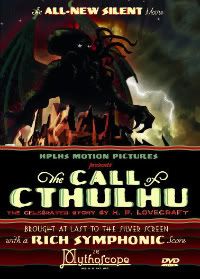
Like Alan Moore's "The Watchmen," H.P. Lovecraft's "The Call of Cthulu" has long been hailed as an unfilmable story. Despite this label though, the film adaptation holds the same suspense of the text while remaining loyal to the storyline. The near-ergodic tale starts with an inquisitive lad at his great-uncle's deathbed. He's being sworn to destroy a manuscript that was in his great-uncle's possession for some time. Naturally he reads it and the film flashes back to his his great-uncle as a youth, first discovering the manuscript. As the great-uncle begins to read, we're treated to another flashback, going up level after level until we finally get to three core stories: a discovery of a strange statue, its presentation to a group of archaeologists and a sighting of a terrifying creature at sea. Then all the flashbacks quickly collapse, the film ends and you may now begin your analysis of the piece for film class. Essay must be 5,000 words in length.
The eerie theme of the film is one of obsession and over-analysis. The three incidents, while distinctly correlated through basic theme, may not be related enough to point to the actual existence of a terrifying creature known as Cthulu. Yet this information continues to madden one curious investigator after the next as the manuscript changes hands. If the beast is truly one of the imagination, nothing more, then it truly gains immortality as the tales change hands and its visage works its way into the minds of the innocent. So in another regard, it could be seen as a social commentary on the prevalence of myths in our culture and how some manage to persist over the decades, despite a changing environment.
As "Brand Upon the Brain" endeavored to do that very same year, "The Call of Cthulu" is intended to be a tribute to silent films. I found it far more accurate and visually pleasing. The makeup on the actors, the conventional camera shots and lighting are all reminiscent of productions from the 1920's. While some scenes were clearly shot digitally, for the better part, the film has a sense of authenticity. And to choose such a complex story to adapt with this filmmaking style is nothing short of ambitious for a production company's debut.
Watch the Trailer

No comments:
Post a Comment